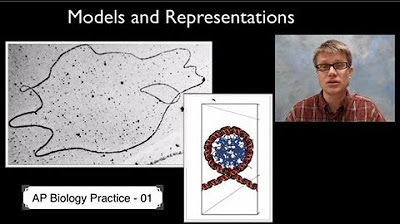AP Biology Lab 5: Cellular Respiration
Summary
TLDRIn this AP Biology Lab 5 walkthrough, Mr. Andersen explains the process of cellular respiration in eukaryotic cells, highlighting the role of mitochondria. The lab focuses on measuring respiration rates using a respirometer with germinating peas and worms, demonstrating how glucose is broken down into carbon dioxide and water, generating ATP. The setup involves using potassium hydroxide to absorb carbon dioxide, allowing for accurate oxygen consumption measurements. Results show that germinating peas respire at a higher rate than non-germinating peas and worms, emphasizing the importance of cellular respiration for energy production.
Takeaways
- 😀 Cellular respiration occurs in eukaryotic cells and primarily takes place in the mitochondria.
- 😀 The process involves breaking down glucose in the presence of oxygen, producing carbon dioxide, water, and ATP (energy).
- 😀 There are three main stages of cellular respiration: glycolysis (occurs outside mitochondria), the Krebs cycle (inside mitochondria), and the electron transport chain.
- 😀 The lab aims to measure the rate of cellular respiration by observing the consumption of oxygen.
- 😀 The experiment uses worms and peas, demonstrating that plants also respire by breaking down sugars produced during photosynthesis.
- 😀 A respirometer is used for the experiment, which consists of a glass jar, cotton, and potassium hydroxide (KOH) to absorb carbon dioxide.
- 😀 Potassium hydroxide converts carbon dioxide into a solid, allowing for accurate measurement of oxygen consumption without volume changes.
- 😀 The setup includes three jars: one with germinating peas, one with non-germinating peas, and one with glass beads as a control.
- 😀 Data collected reveals that germinating peas have the highest respiration rate, followed by worms, while non-germinating peas show minimal activity.
- 😀 Temperature fluctuations can significantly affect respiration rates, making the control beads essential for accurate data interpretation.
Q & A
What is the main purpose of the AP Biology Lab 5 walkthrough?
-The main purpose is to explain cellular respiration in eukaryotic cells and how to measure its rate using a respirometer.
What are the three main steps of cellular respiration mentioned in the transcript?
-The three main steps are glycolysis, the Krebs cycle, and the electron transport chain.
Why is oxygen important in the process of cellular respiration?
-Oxygen is necessary to break down glucose into carbon dioxide and water, ultimately producing ATP, the energy currency of the cell.
What organisms are used in this lab to measure respiration rates?
-The lab uses germinating peas, non-germinating peas, and worms to measure respiration rates.
How does potassium hydroxide (KOH) function in the respirometer?
-KOH absorbs carbon dioxide produced during respiration, converting it into a solid, which allows for accurate measurement of oxygen consumption.
What role do the glass beads play in the experiment?
-The glass beads serve as a control to account for temperature fluctuations that may affect the respiration rate measurements.
How is the rate of respiration calculated in this experiment?
-The rate of respiration is calculated by measuring the amount of oxygen consumed over time, indicated by the movement of an air bubble in the respirometer.
What observation is made regarding the respiration rates of germinating peas compared to non-germinating peas and worms?
-Germinating peas have the highest respiration rate, followed by worms, while non-germinating peas show little to no activity unless soaked in water.
What effect does temperature have on the respiration rates measured in this experiment?
-Temperature fluctuations can significantly influence respiration rates, which is why controls are used to account for these changes.
What can be concluded from the experiment about the importance of respiration in plants?
-The experiment illustrates that plants, like germinating peas, rely on cellular respiration to convert stored sugars into usable energy for growth, even when they are underground.
Outlines

This section is available to paid users only. Please upgrade to access this part.
Upgrade NowMindmap

This section is available to paid users only. Please upgrade to access this part.
Upgrade NowKeywords

This section is available to paid users only. Please upgrade to access this part.
Upgrade NowHighlights

This section is available to paid users only. Please upgrade to access this part.
Upgrade NowTranscripts

This section is available to paid users only. Please upgrade to access this part.
Upgrade Now5.0 / 5 (0 votes)





